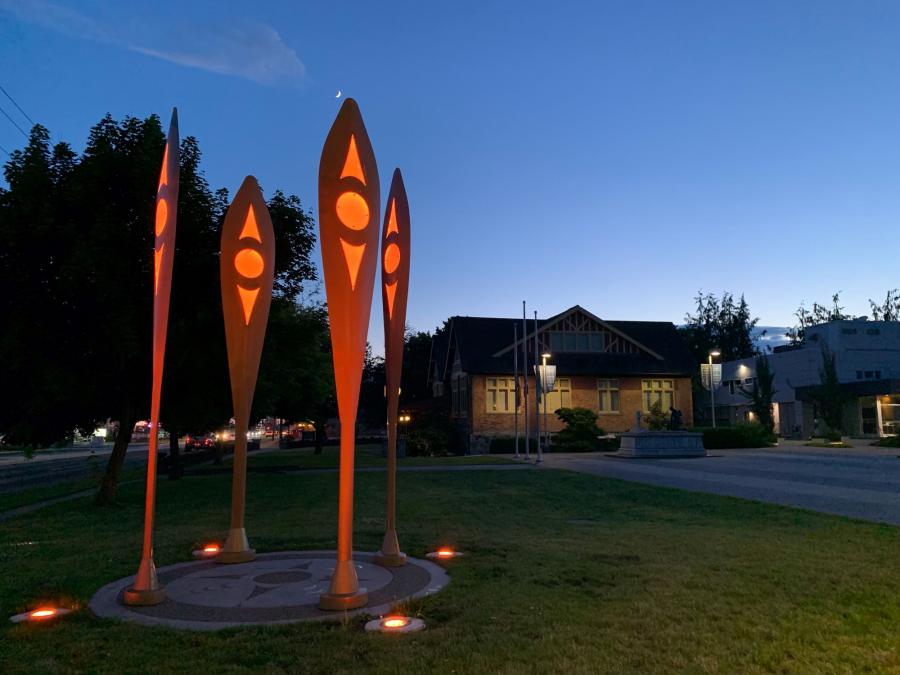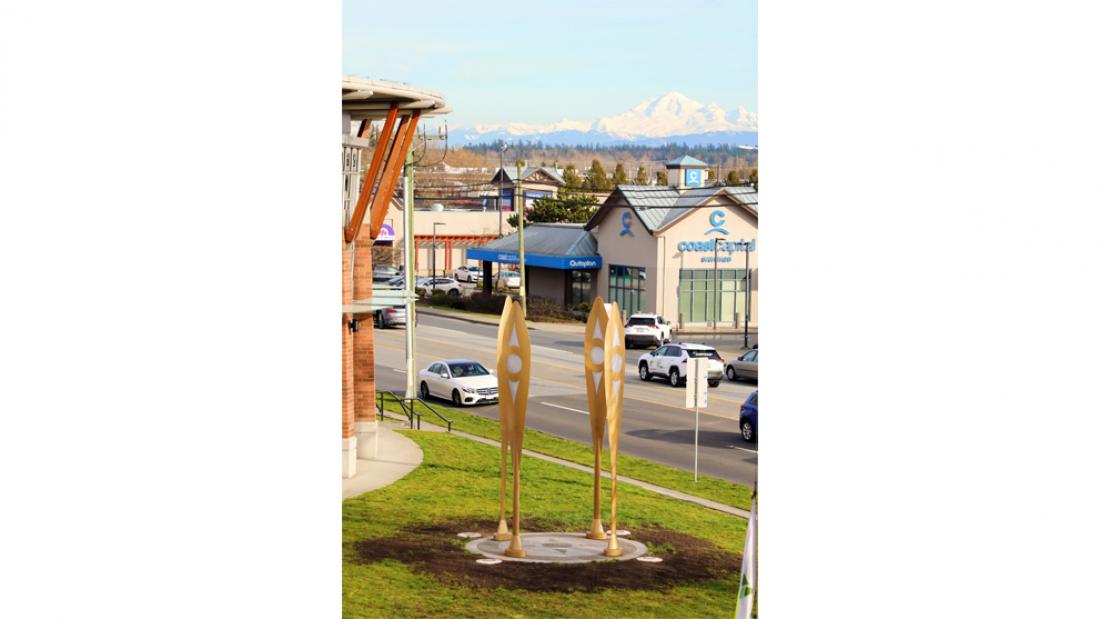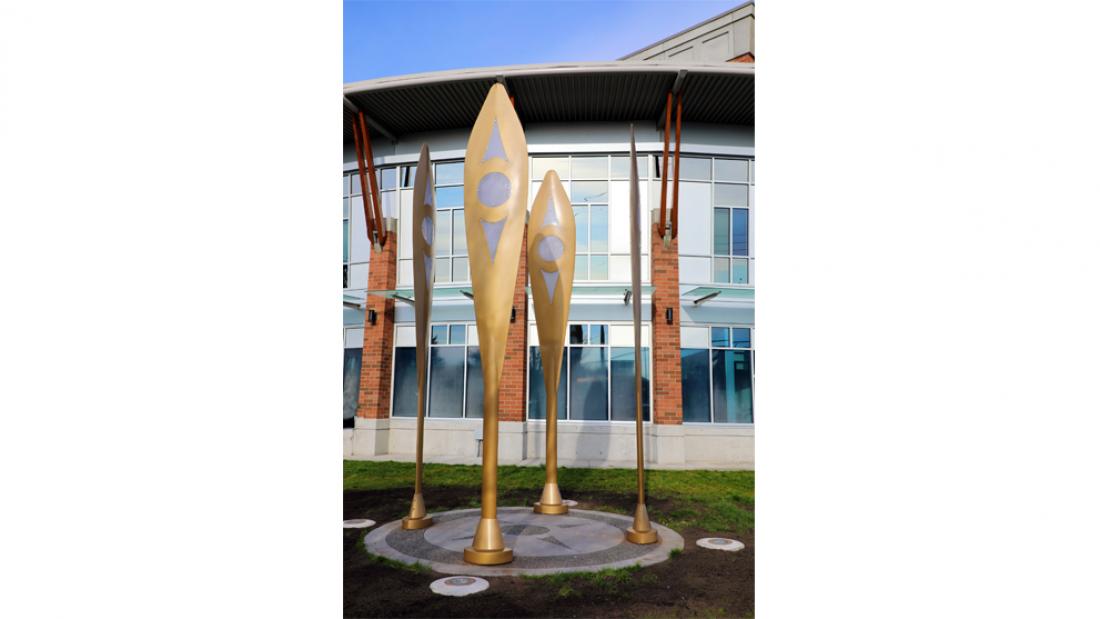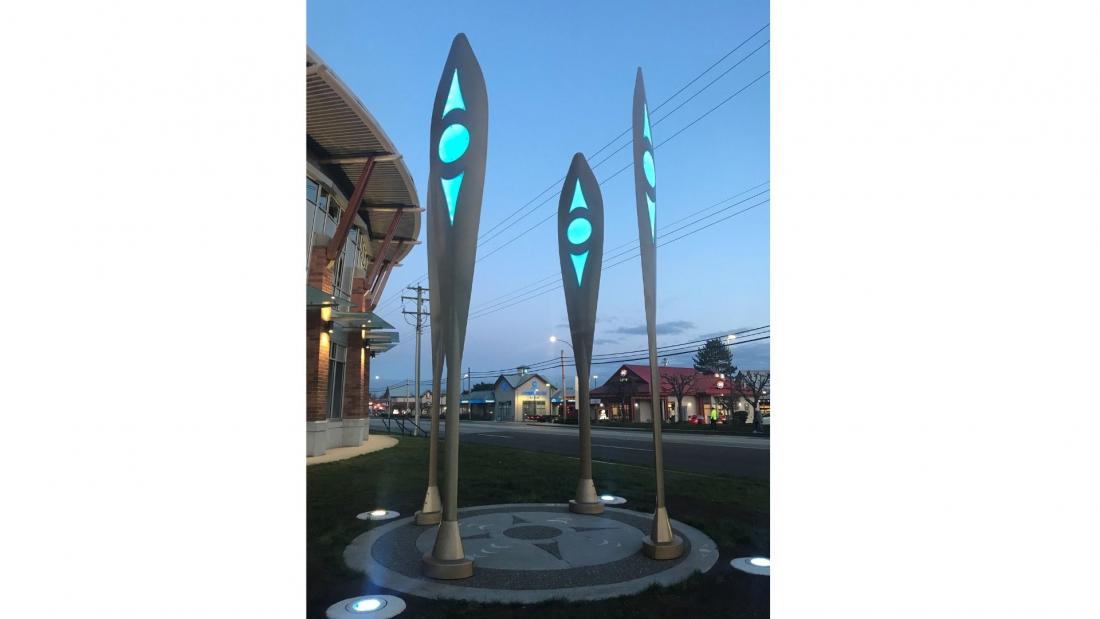The Rivers that Connect Us
These monumental paddles by kʼwyʼiʼyʼe Spring Salmon Studio welcome people to the Museum of Surrey.
Artists: kʼwyʼiʼyʼe Spring Salmon Studio (Drew Atkins, Phyllis Atkins, and Aaron Jordan)
Location: Museum of Surrey (17710 56A Avenue)
Category: Public
Year Installed: 2021
About The Rivers that Connect Us
Designed and fabricated locally, this monumental sculpture makes an important contribution to the Cloverdale Historic District by acknowledging and reflecting the longstanding presence of First Nations peoples. The City of Surrey is sited on the unceded traditional territory of the q̓ʷɑ:n̓ƛ̓ən̓, q̓ic̓əy̓, and səmyəmɑʔɬ (Kwantlen, Katzie, and Semiahmoo Nations).
The artwork’s five-metre-tall, illuminated paddles are raised to the sky, recalling a traditional Coast Salish gesture indicating peace and respect made when a canoe traveller approached a village. The artwork’s welcoming gesture is intended to honour the diversity of newcomers arriving in Surrey and the traditional lands of the Coast Salish peoples.
The sculpture’s four paddles encircle a 3.5-metre round base that features a design inspired by the traditional form of a Coast Salish spindle whorl, a tool used by Coast Salish women to spin wool for weaving. The base also references a compass and the four directions. The Salish Eye designs around the base of the paddles represent the seven traditional teachings of the Kwantlen peoples: health, happiness, generations, generosity, humility, forgiveness, and understanding.
While referencing the deep history of the land and traditional Coast Salish design, the sculpture also incorporates technology with its steel and polycarbonate materials and programmable LED lighting.
In June 2021, at the request of the artists, the lighting colour of their artwork was changed to orange to recognize and raise awareness of the significant impacts of residential schools in Canada. The artists want to also acknowledge and show respect to all survivors, families and Indigenous children who did not make it home.
Phyllis Atkins explained that this is very personal: “My Dad, Grand Chief Joe Gabriel went to St. Mary’s residential school in Mission and two of his sisters Hazel Gabriel and Winnifred Gabriel also attended and did not survive. My Mom, Maureen Gabriel, and many of my aunts and uncles on both sides of my family are residential school survivors and I want to acknowledge and honour them for their resilience."
The artwork also offers an invitation to learn more about the history and heritage of Surrey. It is strategically located beside the Museum of Surrey and near the 1912 Municipal Hall that houses the City’s Archives.
For the artists, The Rivers that Connect Us provided an important opportunity to mark the traditional territories on which Surrey is built. They say, “The Fraser River and its local tributaries—the Salmon, Serpentine, and Nicomekl Rivers—formed a transportation network that connected First Nations people in the area since time immemorial. Relied upon for resource gathering, travel, and trade, these rivers were traversed by canoes from many nations. Presently, the Highway 10 corridor, and its many connecting roads, is today’s river.”
The artwork’s title, The Rivers That Connect Us, is a reminder and an invitation to a shared human connection regardless of cultural or ethnic backgrounds.
About the Artists
Drew Atkins
Drew Atkins (Nəq̓ɑɬc̓i) is a member of the Kwantlen First Nation community by marriage to his wife and fellow artist, Phyllis Atkins (q̓ʷɑt̓ic̓ɑ’s). He works in many mediums including painting, drawing, carving, and sculpture. He was trained in the Coast Salish carving tradition while apprenticing with his dear friend and mentor Xwa-lack-tun (Rick Harry). Atkins owns and operates K’wy’iye’ Spring Salmon Studio and Gallery in unceded Fort Langley, BC with Phyllis Atkins.
His other public artworks in Surrey include Returning to the River and Retro-Perspective.
Phyllis Atkins
Phyllis (Qwoy’tic’a) Atkins is an artist of the Kwantlen First Nation whose name means “I wear the clouds like a blanket” or “Shrouded in clouds.” Her name comes from the Nɬeʔkepmx language and it was given to her by her maternal grandfather Hereditary Chief Anthony Joe of the Shakan Band (Thompson River People). Phyllis is also part Sto:lo (People of the river). Phyllis has taken oil painting lessons from Barbara Boldt and hand-carved silver jewelry lessons by Master Carver Derek Wilson. She is a renowned painter and jeweler at their home on Kwantlen First Nation in Fort Langley.
Her other public artworks in Surrey include Paddling through the Waves of Change, Returning to the River, We Are All Connected to this Land, and Courage, Strength, and Family.
Aaron Jordan
Aaron Jordan grew up surrounded by artists and craftsmen of all mediums. Working for a few years in art galleries and museums led Aaron to attend Langara College to study fine arts. He went on to discover the world of film and was swept up by the creativity and diversity of the industry while working as a sculptor and carpenter building sets and props.



